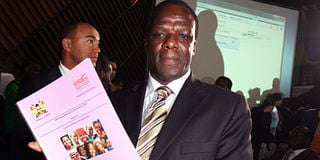How North Eastern figures went wrong

File | NATION
The minister of State for Planning, National Development and Vision 2030, Mr Wycliffe Oparanya, during the launch of the 2009 Kenya Population and Housing Census results at the KICC in Nairobi on August 31, 2010. With him is assistant minister Peter Kenneth.
What you need to know:
- Residents took and filled in questionnaires with inaccurate information, claims minister
Planning minister Wycliffe Oparanya on Wednesday tried to explain how the Sh8 billion census arrived at results which showed that the number of people in one province had increased by 140 per cent in a decade.
The census results for some districts in North Eastern Province have been cancelled and a fresh count ordered after the figures showed its population had risen almost three-fold, from 962,143 in 1999 to 2.3 million last year.
Mr Oparanya said the count was badly conducted after enumerators allowed residents to fill the questionnaires themselves.
The minister said respondents, especially the elderly, refused to answer census questions asked by young enumerators and filled the results on their own, thus compromising the accuracy of the results.
“Most of them refused to be asked questions by our enumerators, saying it was against their culture. They would instead grab the questionnaires and fill them themselves. This led to the inaccuracies,” Mr Oparanya told the Nation.
The population of North Eastern should be 1,394,367 as projected by census officials, said Dr Lawrence Ikamari, the Director of Population Studies at the University of Nairobi.
It is not clear why all the respondents who chose to fill the forms rather than answer questions consistently inflated the sizes of their households. The census questionnaire is a complex, technical document and enumerators have to be trained to fill it.
How elderly people in the depths of North Eastern, where more than 80 per cent of the people are illiterate, were able to understand the questionnaire was another mystery.
Census officials got alarmed when North Eastern residents demanded that a second batch of questionnaires be sent, saying the first one was not enough, the minister revealed.
“We had counted all the households in the province and on the basis of this, took an equal number of forms there. Suddenly, we were told that the forms were not enough so we airlifted more forms there. We started suspecting something was wrong when they asked for extra forms for the third time.”
Population experts are calling for a recount, saying the numbers don’t add up.
“The figures do not conform with the natural population trends. There is a need for the re-evaluation of the fertility and mortality rates as well as migration patterns,” said Dr Ikamari.
A re-evaluation will enable the government to get the true figures and therefore be able to allocate resources in a fair and equitable manner.
According to the Interim Independent Electoral Commission, the province has 232,099 registered voters, only 10 per cent of the total population.
In other provinces, registered voters are normally above 20 per cent of the total population.
But nominated MP Mohammed Affey, who comes from the province, dismissed views that the population in the province was unusually high.
“The population has been understated, the figure could have been much higher if the exercise was done accurately especially in places like Wajir South,” he said.
Experts are particularly puzzled by the big difference between the projected population and the actual population. Population forecasting has become a reasonably accurate science.
In other provinces, the projected population was only slightly higher than the actual number.
Census officials said they detected anomalies in eight districts, five of them in North Eastern, and ordered a recount. They eight include Mandera Central, Mandera East, Mandera West, Lagdera, Wajir East, Turkana Central, Turkana South and Turkana North, the last three in Rift Valley.
Number of households
In these districts, they observed that the reported increase in population did not correspond with the number of people being born and those who were dying.
Also, the number of people was reported to have increased, but not the number of households.
According to the latest Kenya Demographic and Health Survey, North Eastern has the highest fertility rate, currently standing at 5.9 per cent and an equally high mortality rate.
Infant mortality, the death between birth and the first birthday and the under-five mortality, the death between birth and the fifth birthday were still high in the province due to inadequate health facilities.
About 57 infants die per every 1,000 live births, while that for under-fives currently stands at 80.
This is above the national average of 52 infants per 1,000 births and 74 under-fives in every 1,000.
Only 48 per cent of children between 12 and 23 months in North Eastern were fully vaccinated, exposing the new-borns to diseases and deaths. Experts pointed at the male-female ratio, saying it did not conform to normal population trends.
The province recorded 1.2 million males against 1.0 million females and was one of the three provinces where men outnumbered women. The other two provinces being Rift Valley and Nairobi.
“In most African set-ups, there are bound to be slightly more women than men and the margin increases with age because the mortality rate of men is higher.
That is why you tend to see more widows than widowers in most areas,” said Dr Ikamari.




